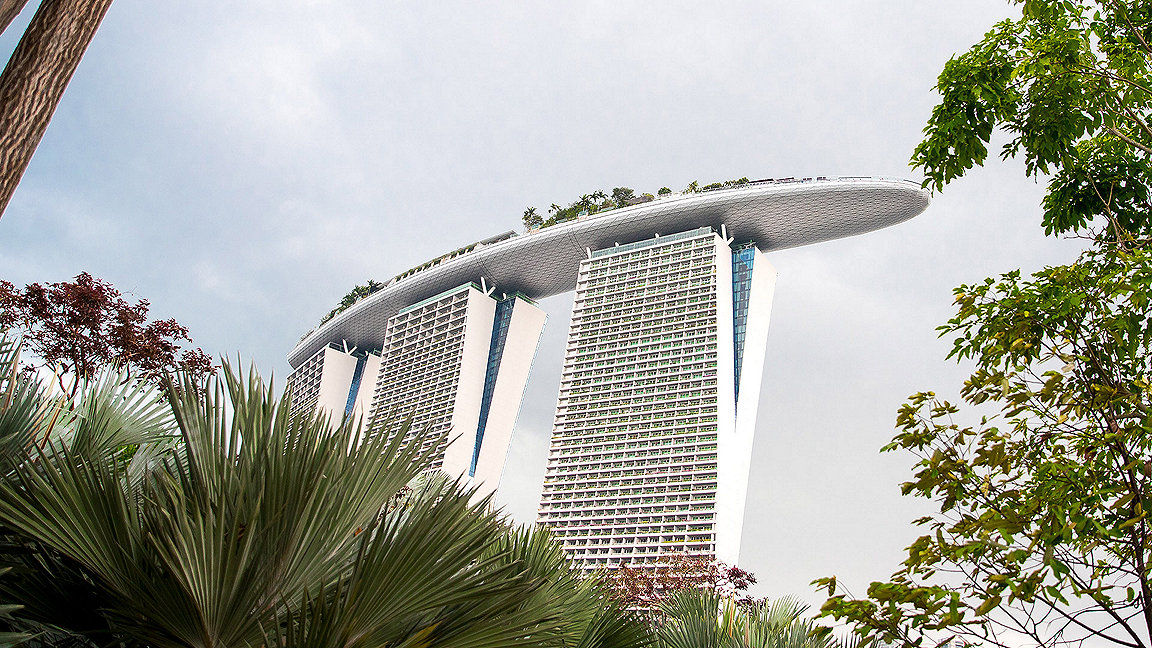
When architect Moshe Safdie was told by the original developer of the Marina Bay Sands complex that they wanted just one tower in the city’s new marina, his remarks were that it would have been “unbearable”.
It would, he said in a 2014 interview, have created a wall, separating Singapore’s downtown from the seafront. Instead, Safdie delivered a trilogy that would completely alter the Singaporean skyline. Three towers, each 55-storeys high, where the sun could shine through and the view could be seen beyond, all connected by a sky garden.
“Symbolically [one tower] would be unbearable, so I proposed three … framed above, which created two big windows to the sea … you can see either way through the building to the other parts of the city,” said Safdie in the interview with Dezeen.
This was exactly what the Singapore government wanted: a statement building, to boost the country’s tourism economy, and see off stiff competition from regional economies such as Hong Kong. “They wanted a museum piece for Singapore, and by that definition it had to be an iconic structure,” says Nicola Greenaway, managing director of Singapore-based design company, NIKAU “[The government] used the Sydney Opera House as an example of what a building could do for tourism.”
Reclaiming land from the sea
The idea for the area of Marina Bay (that surrounds the downtown core of the city-state) dates to the early 1970s, and to Singapore’s aspiration of becoming a business and financial hub. It was then the city’s planners, the Urban Redevelopment Authority, saw that by reclaiming land, they could expand the city centre.
It was a long time in the making, taking over 20 years from 1971 to 1992, for the land reclamation. Developments such as the Marina Bay Financial Centre, Gardens by the Bay, and Asia Square followed in the next two decades.
But as the 845,000m2 Marina Bay Sands complex started to emerge from the previously watery depths, the skyline of Singapore was permanently changed. “There was nothing there before,” says Bill Jones FRICS, RICS Governing Council member and Singapore-based real estate consultant. “You could see Indonesia and Malaysia from my office in the financial district. Then Marina Bay Sands became a backdrop from Singapore to the marina view of the Straits, the sea, and the Indonesian islands beyond. It was very dramatic in the way it was constructed, and it is still dramatic now.”
The complex was built by gaming giant Las Vegas Sands with a price tag of US$6.88bn, said to be the world’s most expensive standalone casino at the time. Officially opened in 2010, it has 2,561 rooms, and is also home to restaurants, a theatre, convention and exhibition facilities, The Shoppes (a shopping mall), two floating crystal pavilions, a museum, and art-science exhibits.
The crowning glory is the 1.2ha SkyPark, that can hold nearly 4,000 people. “We had the dilemma of where to put the swimming pool. How do we make this a resort?” said Safdie. “That's when the idea of the SkyPark was born. It's on the 57th floor, it's 2.5 acres cantilevering 65 metres off the tower with all these gardens, and it's proven to be magical.”
And it gave the Singapore Government its goal of achieving their ‘Sydney Opera House’. In the nine years from opening, until 2019, before COVID-19 and restrictions, it attracted over than 330m visitors.
“We had the dilemma of where to put the swimming pool. How do we make this a resort? That's when the idea of the SkyPark was born” Moshe Safdie, Safdie Architects
“[The government] used the Sydney Opera House as an example of what a building could do for tourism” Nicola Greenaway, NIKAU


“It had to be an iconic structure” Nicola Greenaway, NIKAU
The fourth tower
More development is planned for Marina Bay Sands. In 2019, a US$3.3bn expansion was announced, where original architect Safdie would design a fourth tower next to, but not linked to, the existing three, that includes 1,000 luxury rooms, a 15,000-seat arena, and its own sky roof.
“It’s in the same aesthetic as the other [towers]. There’s a sympathetic approach to keeping the design consistency,” says Greenaway. Construction will start next April, with an opening date of 2026. The existing complex is also undergoing a US$1bn renovation, upgrading rooms and suites, that will be completed in phases this year and next.
Marina Bay Sands and Singapore have bounced back spectacularly from COVID-19 lockdowns. In July, the Singapore Tourism Board revealed hotel room rates in the city-state in June were the highest in almost six years after the government eased coronavirus measures.
“It was very dramatic in the way it was constructed, and it is still dramatic now” Bill Jones FRICS, real estate consultant



Meanwhile Marina Bay Sands reported its highest quarter of casino revenue since the onset of COVID-19 in 2020, hitting US$390m between April and June 2022. And in July the complex got five Singapore Tourism Awards, including the Special Award for Sustainability.
For residents and those visiting Marina Bay Sands and the surrounding area, the developments represent a new way of life. “The waterfront promenade has now become a meeting place for both Singaporeans and tourists, who gather there either to marvel at the free daily light performances or appreciate the serene waterfront view,” says Alexander Chng, architect director, BDP Singapore.
Or as Greenaway puts it: “Marina Bay Sands really is our legacy now.”





